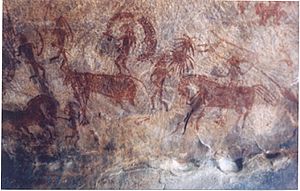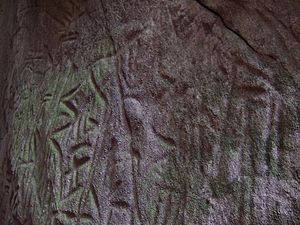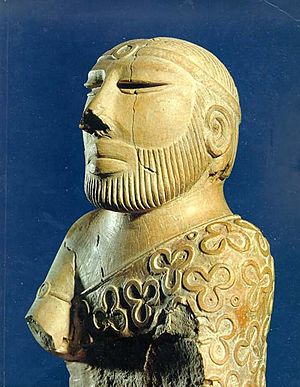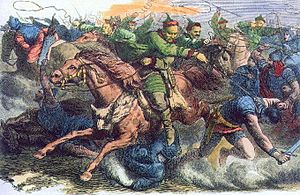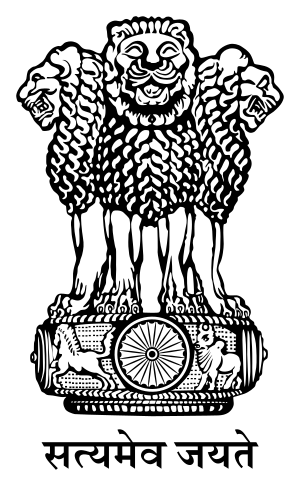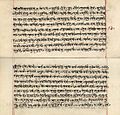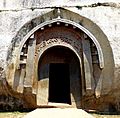History of India facts for kids
India has a very long and interesting history, going back thousands of years! It's filled with many different time periods and powerful ruling families called dynasties. We can explore India's past by looking at these main parts:
Contents
Ancient India: The Stone Age
Early Stone Age: Paleolithic Era
Imagine humans living in India hundreds of thousands of years ago! Archeologists have found old stone tools and even a skull in central India. These belonged to an early type of human called Homo erectus. Experts believe they lived here between 200,000 and 500,000 years ago. This very old time is known as the Paleolithic era.
The oldest human sites in this region are found in the Soan River valley. Similar sites from this period are also found across India, Pakistan, and Nepal.
Middle Stone Age: Mesolithic Era
Modern humans, Homo sapiens, arrived in India at least 12,000 years ago. This was right after the last Ice Age ended, and the weather became warmer and drier. Some of the first places where humans settled in India are found in Bhimbetka, near Bhopal. People during the Mesolithic period survived by hunting animals, fishing, and gathering food.
New Stone Age: Neolithic Era
About 7,000 years ago, people in the Indus Valley region (which is now Pakistan) started farming. Later, around 5,000 years ago, farming began in the lower Ganges River valley. Agriculture then spread to South India and other parts of India around 3,800 years ago.
Copper Age: Chalcolithic Era
This period saw people using copper tools. It covered parts of modern-day Maharashtra, but not the Vidarbha region or the coastal Konkan area.
The Bronze Age: Indus Valley Civilization
The Bronze Age in India began around 5,300 years ago. This was when the early Indus Valley Civilization started. It included famous cities like Harappa, Mohenjo-daro, Lothal, and Kalibanga. This civilization was built around the Indus River and its smaller rivers. It stretched into parts of modern-day India (like Gujarat and Punjab) and Pakistan (like Sindh and Balochistan).
The Indus Valley Civilization was one of the world's first urban civilizations. It existed at the same time as ancient Mesopotamia and Egypt. The people of this civilization, called Harappans, were very skilled. They developed new ways to work with metals and create beautiful handicrafts. They used copper, bronze, lead, and tin.
The main period of the Indus Civilization was from about 4,600 to 3,900 years ago. Their cities were well-planned, with brick buildings, good drainage systems along the roads, and even multi-story houses. Important cities included Dholavira, Ropar, and Rakhigarhi in India, and Harappa and Mohenjo-daro in Pakistan.
Later, the civilization slowly started to decline. By about 3,700 years ago, most of the big cities were empty. However, the Indus Valley Civilization didn't just vanish. Some people likely continued to live in smaller villages and farms.
The Vedic Civilization
The Vedas are India's oldest teachings. For a long time, these teachings were passed down by speaking, not writing, until about the 5th century BC. There are four Vedas. The first and oldest is the Rigveda. It describes the "Land of Seven Rivers" where the Aryans first settled. The other three Vedas are the Samveda, Yajurveda, and Atharvaveda. The Vedas contain verses praising gods and other important information. During this early Vedic period, society was mainly focused on raising animals.
After the Rigveda period, people started farming more. Society also became divided into four main groups based on their work. Brahmins were priests and teachers. Kshatriyas were warriors. Vaishyas were farmers, traders, and business people. Shudras were the general working class. This system of social division is called the Varna system in Hinduism. In the early Vedic age, these divisions were not as strict as they became later.
During the Vedic civilization, many Aryan groups and tribes existed. Some of them joined together to form larger kingdoms, like the Kurus.
Persian and Greek Invasions
Around 500 BC, the northwestern parts of India were invaded by two powerful groups: the Achaemenid Empire (from Persia) and later the Greeks led by Alexander the Great. This brought new ideas about government, lifestyle, and culture to India. This influence became even stronger during the Mauryan dynasty.
Darius I of the Achaemenid Empire ruled large parts of northwestern India starting around 520 BC. Then, Alexander the Great conquered these areas. A historian named Herodotus wrote that these Indian regions were the richest parts of Alexander's empire. Persian rule lasted for about 186 years. Even today, you can still find traces of this Greek heritage in parts of northwestern India.
Greco-Buddhism was a mix of Greek and Buddhist cultures. This blend developed for 800 years, from the 4th century BC to the 5th century AD. It happened in areas that are now Afghanistan and Pakistan. This cultural mix greatly influenced Mahayana Buddhism and helped spread Buddhism to China, Korea, Japan, and Tibet.
The Magadha Empire
Magadha was one of the sixteen important kingdoms in ancient India. It was located in the area of Bihar, south of the Ganges River. Its first capital was Rajagriha, and later it moved to Pataliputra (modern-day Patna).
Magadha grew to include most of Bihar and Bengal, and then parts of eastern Uttar Pradesh and Orissa. The ancient kingdom of Magadha is mentioned in old Jain and Buddhist writings, as well as in Hindu texts like the Ramayana and Mahabharata.
Magadha was very important for the growth of Jainism and Buddhism. Two of India's greatest empires, the Maurya Empire and the Gupta Empire, started in Magadha. These empires saw amazing progress in science, math, astronomy, religion, and philosophy. This time is often called India's "Golden Age."
Early Middle Kingdoms
Satavahana Empire
The Satavahanas, also known as Andhras, became powerful around 230 BC. For about 450 years, many Satavahana kings ruled most of southern and central India.
Western Kshatrapas
For about 350 years (from 35 AD to 405 AD), Saka kings ruled parts of western and central India. These areas are now in the states of Gujarat, Maharashtra, Rajasthan, and Madhya Pradesh. There were 27 different rulers, known as the Kshatrapas.
Saka kings ruled alongside the Kushan kings and the Satavahana kings. Kushan kings ruled northern India, while Satavahana kings ruled central and some southern parts.
Indo-Scythians
The Indo-Scythians came to India from Siberia, traveling through places like Bactria and Kashmir. They arrived between the 2nd and 1st centuries BC. They defeated the Indo-Greek rulers and then ruled India from Gandhara to Mathura.
Gupta Dynasty: India's Golden Age
The Gupta dynasty ruled from about 320 AD to 550 AD. Their empire covered most of North-central India, including what is now western India and Bangladesh. Gupta society followed Hindu beliefs. The time of the Gupta Empire is known as the Golden Age of India. Historians compare the Gupta dynasty to other great classical civilizations like the Han and Roman Empires.
Hun Invasion
By the early 5th century, a group called the Huns settled in Afghanistan and became very strong. They made Bamiyan their capital and started attacking northwestern India. Skandagupta, an emperor of the Gupta dynasty, fought them off for a few years. But eventually, the Huns won and entered most of northern India. This led to the end of the Gupta dynasty.
Northern India was badly affected by this invasion. However, the Huns could not reach the Deccan Plateau or southern India, which remained peaceful. No one knows exactly what happened to the Huns after the late 6th century. Some historians believe they fully blended with the Indian people of that time.
Late Middle Kingdoms
In India's history, the "Middle Kingdoms" period begins around the 6th or 7th century. In South India, the Chola kings ruled Tamil Nadu, and Chera kings ruled Kerala. They traded with the Roman Empire in the west and Southeast Asia in the east. In North India, many Rajput kingdoms emerged, and some lasted for hundreds of years.
Harsha's Empire
After the Gupta Empire fell, a ruler named Harsha from Kanauj (in Uttar Pradesh) united the northern parts of India into one kingdom. After his death, several dynasties tried to control North India from the 7th to the 9th century. These included the Pratiharas, the Palas of Bengal, and the Rashtrakutas of the Deccan.
The Pratiharas, Palas, and Rashtrakutas
The Pratihara kings ruled kingdoms in Rajasthan and other parts of northern India from the 6th to the 11th century. The Palas ruled the eastern part of India, including areas now in Bihar, Jharkhand, West Bengal, and Bangladesh, from the 8th to the 12th century. In southern India, the Rashtrakutas ruled the Deccan Plateau from the 8th to the 10th century. All three of these powerful dynasties often fought to control all of North India. During these centuries, the Chola kings in the south were also growing stronger.
The Rajputs
In the 6th century, several Rajput kingdoms appeared in Rajasthan. Many other Rajput kings ruled in different parts of North India. Some of these kingdoms continued for hundreds of years throughout India's history.
Vijayanagar Empire
In 1336, two brothers, Harihara and Bukka, founded the Vijayanagara Empire in what is now Karnataka state. The most famous king of this empire was Krishnadevaraya. In 1565, the empire's rulers were defeated in a major battle. However, the empire continued for about another hundred years.
Many kingdoms in South India had strong trading relationships with Arab countries in the west and with Indonesia and other countries in the east.
Islamic Sultanates
Islam spread across India over about 500 years. In the 10th and 11th centuries, Turks and Afghans invaded India and set up sultanates in Delhi. In the early 16th century, descendants of Genghis Khan came through the Khyber Pass and established the Mughal Empire, which lasted for 200 years. From the 11th to the 15th centuries, southern India was mainly ruled by Hindu Chola and Vijayanagar Dynasties. During this time, Hindu and Muslim cultures mixed, leaving lasting influences on each other.
Delhi Sultanate
The Slave dynasty was started by Qutub ud din Aibak. He began building the Qutub Minar, the first major Muslim architectural work in India. Qutub ud din Aibak died while playing polo. His successor, Iltumish, finished the Qutub Minar. Iltumish's daughter, Razia Sultan, became the first woman ruler. Even though she ruled for only three years, she brought in many new changes.
The Kingdom of Mysore
The Kingdom of Mysore was a kingdom in southern India. The Wodeyar family founded this kingdom in the year 1400. Later, Hyder Ali and his son, Tipu Sultan, fought against the Wodeyar rulers. They also fought against the British, but were defeated. Under British rule, Wodeyar kings continued to rule a large part of Karnataka. When India became independent on August 15, 1947, the Wodeyars' kingdom chose to join India.
The Punjab and the Sikh Empire
Guru Nanak founded Sikhism, and his followers were called Sikhs. The Sikhs grew powerful in northwestern India and became rulers of a large area. This was known as the Sikh Kingdom or Empire. Ranjit Singh was the most famous ruler of the Sikh Empire. He expanded its borders to include Punjab, Kashmir, and parts of Pakistan. The Sikhs and the British fought many wars. As long as Maharaja Ranjit Singh was alive, the British could not cross the Sutlej River. After his death, the British took over Punjab after battles with the disorganized Sikh troops.
Durrani Empire
For a short time, a person named Ahmed Shah Durrani ruled some parts of northwestern India. Historians call his rule the Durrani Empire. In 1748, he crossed the Indus River and attacked Lahore (now in Pakistan) and many parts of Punjab. Then, he attacked Delhi, which was the capital of the Mughal Empire. He took many valuable things from India, including the famous Kohinoor diamond.
The Colonial Era
The Colonial period is when Western countries ruled India and many other countries in Asia, Africa, and South America.
Company Rule: The British East India Company
Starting in the 1600s, the British East India Company began a very profitable trading business in India, mainly in Bengal. In the mid-1700s, Robert Clive led the Company to gain more power in India. He won battles against the French, the Bengalis, and the Mughals. After winning the Battle of Plassey in 1757, Clive became the first British Governor of Bengal.
Over the next hundred years, the East India Company took control of all of India. They did this through trade, clever political moves, and direct military action. The British were very good at managing their territories. But in 1857, the Indian Mutiny (a rebellion) almost destroyed the Company's rule. After this, the British government took control away from the Company. In 1858, India became part of the British Empire, and Queen Victoria became the Empress of India.
The British Raj
For ninety years, the British ruled India and Burma as one territory under the British king or queen. It was divided into eight provinces, each with a governor. A Governor-General (Viceroy) in Calcutta was in charge of the government.
The British did some harmful things to India's culture and society. They took valuable items and treated many Indians badly. They often used a "divide and rule" strategy to conquer India. Many kingdoms were defeated, and their riches were taken. For example, many of the British Royal Crown Jewels, including the Koh-i-Noor diamond, were taken from Indian kingdoms.
During famines and floods, many people died because the government did not help enough. Indians who couldn't pay British taxes could be put in prison or publicly beaten. People who spoke out against British rule were jailed and sometimes killed. After taking India's natural resources for hundreds of years, England was criticized for not protecting Indians during the partition of India and Pakistan. Millions of people died during this partition.
However, the British also did some good things. They built railroads, telegraphs, and telephones, which improved trade. They also standardized laws and improved water supplies. Many of these improvements helped British commerce in India and sent profits back to England. They created the Indian Civil Service to manage rules. They also tried to stop practices like the burning of widows.
The British mainly ruled India for Britain's economic benefit. India provided cheap raw materials for British factories. Indians had to buy British-made goods, and the profits went back to Britain.
The Independence Movement
Many people in India wanted to be free from British rule. The fight for independence was long and hard. The most important leader of this struggle was Mahatma Gandhi. Gandhi believed in non-violent resistance against the British.
India won its independence, along with Muslim Pakistan, and became a free country on August 15, 1947.
Republic of India
On August 15, 1947, the British Indian Empire was divided into two new countries: India (also called Hindustan) and Pakistan. This marked the end of British rule in India. On January 26, 1950, India adopted its own constitution. From that day, Hindustan became the Republic of India.
Over the last 60 years, the Republic of India has experienced many important events:
- India fought three wars against Pakistan (in 1947, 1965, and 1971) and one war against China (in 1962). In 1999, there was also a smaller conflict in Kargil. In 1971, India helped Bangladesh gain its freedom.
- Under its first Prime Minister, Jawaharlal Nehru, India adopted a mixed economy. This meant it combined ideas from socialism and capitalism. During this time, which lasted until the late 1980s, India quickly developed its infrastructure, science, and technology.
- By the early 1990s, India changed its economic policies. It started reforms to attract more money from other countries. Local business people also gained more freedom to run their activities.
- In 1974, India successfully tested its first nuclear bomb. It did so again in 1998, becoming a nuclear power.
Currently (as of 2006), India is the tenth largest economy in the world based on its total economic output (GDP). It is the 4th largest economy when considering purchasing power parity (how much you can buy with money). Some economists believe that India's economy will grow even larger in the coming decades.
Images for kids
-
Mehrgarh site, in Beluchistan, Pakistan
-
Mohenjo-daro, one of the largest Indus cities. View of the site's Great Bath, showing the surrounding urban layout.
-
Dholavira, a city of the Indus Valley civilisation, with stepwell steps to reach the water level in artificially constructed reservoirs.
-
Archaeological remains of washroom drainage system at Lothal
-
Three stamp seals and their impressions bearing Indus script characters alongside animals: "unicorn" (left), bull (center), and elephant (right); Guimet Museum
-
An early 19th century manuscript in the Devanagari script of the Rigveda, originally transmitted orally with fidelity
-
Manuscript illustration of the Battle of Kurukshetra.
-
The Mahajanapadas were the sixteen most powerful and vast kingdoms and republics of the era, located mainly across the Indo-Gangetic plains.
-
Silk Road and Spice trade, ancient trade routes that linked India with the Old World; carried goods and ideas between the ancient civilisations of the Old World and India. The land routes are red, and the water routes are blue.
-
Coin of Emperor Harsha, c. 606–647 CE.
-
Excavated ruins of Nalanda, a centre of Buddhist learning from 450 to 1193 CE.
-
The Delhi Sultanate reached its zenith under the Turko-Indian Tughlaq dynasty.
-
The Dasam Granth (above) was composed by Sikh Guru Gobind Singh.
-
Jain Tirthankara Mahavira with Yaksha Matanga and Yakshi Siddhaiki at Ellora Caves.
-
Brihadeeswara Temple Entrance Gopurams at Thanjavur.
-
Gol Gumbaz built by the Bijapur Sultanate, has the second largest pre-modern dome in the world after the Byzantine Hagia Sophia.
-
The Red Fort, Delhi, its construction begun in 1639 CE, and ended in 1648 CE.
-
Watercolor (1863) titled, The Ganges Canal, Roorkee, Saharanpur District (U.P.). The canal was the brainchild of Sir Proby Cautley; construction began in 1840, and the canal was opened by Governor-General Lord Dalhousie in April 1854
-
Bahadur Shah Zafar the last Mughal Emperor, crowned Emperor of India by the rebels, he was deposed by the British, and died in exile in Burma
-
Srinivasa Ramanujan (1887–1920) was an Indian mathematician who made seminal contributions to number theory.
-
India Gate is a memorial to 70,000 soldiers of the British Indian Army who died in the period 1914–21 in the First World War.
-
From the late 19th century, and especially after 1920, under the leadership of Mahatma Gandhi (right), the Congress became the principal leader of the Indian independence movement. Gandhi is shown here with Jawaharlal Nehru, later the first prime minister of India.
-
Jawaharlal Nehru being sworn in as the first prime minister of independent India by viceroy Lord Louis Mountbatten at 8:30 AM 15 August 1947.
See also
 In Spanish: Historia de la India para niños
In Spanish: Historia de la India para niños


